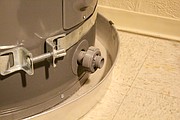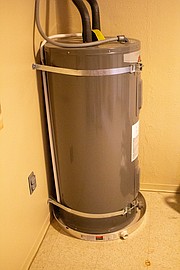When freezing temperatures drop, it’s a good time to make sure a home’s pipes and faucets are properly protected from winter frosts.
Mike Radder of Word of Mouth Services Inc. in Moses Lake said now is the time of year to make sure garden hoses are disconnected every night outside of a home.
“A lot of people come here from the coast and leave their garden hose on and we’ll have severe frost overnight and they won’t even notice and it will freeze and break,” said Radder.
Radder said many homeowners will experience a quick freeze in the fall, not even knowing they had a line break. Make sure that any outside openings in a house are properly sealed to protect the plumbing under a house. Covering ventilation covers is important, especially with north winds.
Radder said he was under houses and watched the frost blow from the north and the copper pipe under the houses splintered after freezing.
“When it reaches minus 10 degrees and the wind comes from the north, I know that I will have a day full of nothing but emergency repairs to the water pipe,” said Radder. “We won’t even be able to answer all the calls.”
If all the vents and faucet spouts are closed before winter, he said they should be fine. For homeowners in rural areas with pump houses, now is a good time to make sure the heater with the pump house is working free of fire hazards.
Radder says having a battery-powered temperature alarm is a good idea even in the event of a power outage or overvoltage. He said he saw digital alarms reset and not turn on after a power surge, causing a pump house to freeze and everything to be destroyed in a matter of hours.
In addition to protecting against the incoming cooler temperatures, Radder said spring and fall are good times to flush sediment out of a water heater.
Radder said he himself was guilty of not doing this on a regular basis, but he had the training and expertise to correct a problem should one arise. He said it was a good idea to connect a hose to the bottom of a water heater and flush out any sediment build-up as calcium can build up in it.
“It wraps or covers the lower element, insulates it and burns the element out,” said Radder.
Spring and fall are often the times of the year when he sees the biggest problem with root penetration into systems, as trees want to take in additional nutrients before winter. Radder said he recommends using root kill or root intrusion products that are approved for the pipes used in a home.
An inspection with a sewer camera can help educate a homeowner if a root break is a problem. Generally, if someone is concerned about a break in their line that will allow roots, adding a root kill additive to the system once a year if it isn’t too severe.
While roots are a problem at this time of year, Radder says kitchen lines are always the top issues people have issues with constipation, mostly because of food fat buildup. When a homeowner is in a septic tank, adding anaerobic bacteria to the tank can help reinforce the bacteria that fight food fat buildup.
He said he does not recommend using acid-based products at all as these can be extremely disastrous for pipes. Another thing to avoid is adding things like chlorine tablets to the back tank of toilets.
“These things just sit there and grill the plastics; they super-oxidize them and your flapper will rot radically faster, about a tenth of its life, ”said Radder.




Comments are closed.